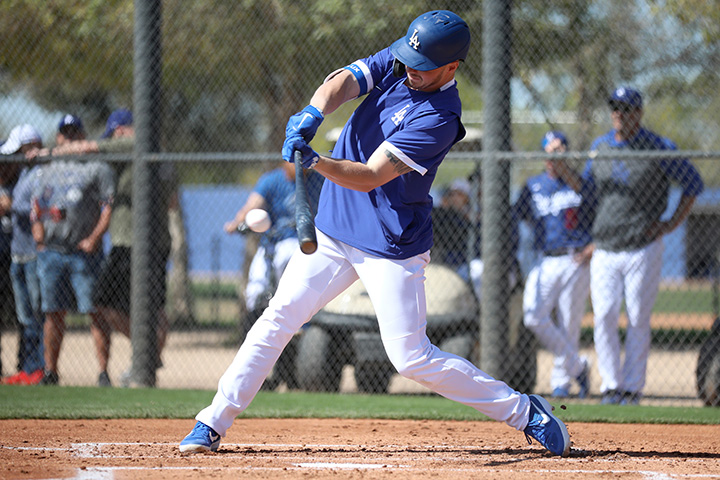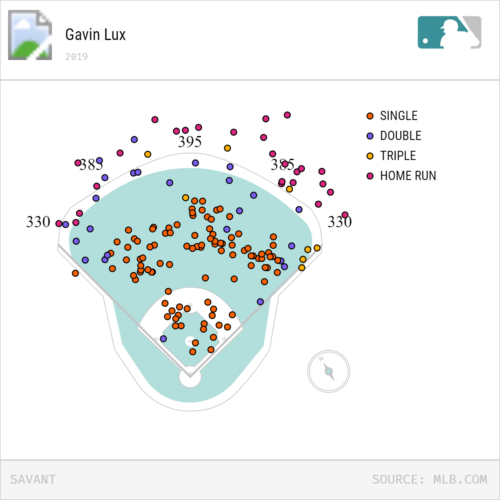We’ve finally reached No. 1. I’m sure there wasn’t much drama, as Gavin Lux is, easily, the best prospect in the system.
——
Previous Entries
- Introduction
- 100-51
- 50-41
- 40-31
- 30-21
- 20-11
- No. 10 – Michael Busch
- No. 9 – Kody Hoese
- No. 8 – Diego Cartaya
- No. 7 – Brusdar Graterol
- No. 6 – Keibert Ruiz
- No. 5 – Miguel Vargas
- No. 4 – Tony Gonsolin
- No. 3 – Josiah Gray
- No. 2 – Dustin May
——
I’ve included Future Value (FV) grades and risks for the Top 50 prospects. For example, if a guy gets a “50 low,” he has a really good chance to be an average player at his position. If a guy gets a “55/High,” there’s a good chance he won’t reach that ceiling, but the potential is there. The grades are 20-80 (50 is average), and the risks are as follows:
- Low: Players who are usually older, have debuted, are relievers and/or have higher floors than ceilings
- Medium: Players who are a mix of younger and older, usually have higher floors
- High: Players who are usually younger with potential, but also question marks
- Extreme: Players who are generally younger with star potential, but a ton of question marks
This is to show what value a player might provide at the MLB level. The higher the risk, the less likely a player will reach that ceiling.
——
Editor’s Note: I am not a scout (#notascout). I am an amateur when it comes to evaluating players. I don’t claim to be a pro, I just want to pass along the information I observe/obtain to the people. Notes and comments are based on personal observation, talking to sources, reading scouting reports and watching video. For future entries in this series: All ratings in the charts below are on the standard 20-80 scouting scale, where 50 is roughly average, 80 is elite and nearly unattainable and 20 is unacceptably poor. Enjoy.
Other Notes: “Role” is a realistic future role (slightly optimistic in some cases). Age is the 2020 season age for the player (June 30 is the cutoff date).
——
Rating Key
| 80 — Elite |
| 75 — Borderline Elite |
| 70 — Plus-plus |
| 60-65 — Plus |
| 55 — Above-average |
| 50 — Average |
| 45 — Fringe-average |
| 40 — Below-average |
| 30-35 — Poor |
| 20-25 — Very Poor |
1. Gavin Lux
| DOB: 11/23/97 | Age: 22 | Height: 6’2 | Weight: 190 | Bats: Left | Throws: Right | Position: SS/2B |
Acquired: 1st round (No. 20 overall) of 2016 MLB Draft, Indian Trail HS (Wisc.), $2,316,300 signing bonus
Physical description: Athletic, solid build, stout
Strengths: Premium hit tool for middle infielder, above-average power, athleticism and speed
Weaknesses: Might not stick at SS long-term, footwork, lacking premium arm strength
Key statistics: .240/.305/.400, 8.5 BB%, 29.3 K%, .160 ISO (MLB)
Role: Top-of-the order middle infielder
Player comparison: Chase Utley
Summary: No one — not even Billy Gasparino and the Dodgers — ever thought Lux would develop into this kind of prospect despite being a 1st-rounder. He has improved every year of his pro career and found his way to the majors at age 21. He dominated Double- and Triple-A last summer to the tune of .347/.421/.607 and a career-best 26 home runs. He got the call on Sept. 2 and promptly went 2-for-5 in his first game. In his first postseason at-bat — yes, he made the Dodgers’ NLDS roster — he homered. Lux has established himself as one of the best prospects in the game.
Since the 2018 season that saw him breakout, Lux began to use his legs more in his swing. As a result, he increased his fly ball rate, which led to move over-the-fence power. He has plus-power potential that could lead to him being a 20-plus home run hitter. What he does really well is hit line drives all over the field. His above-average bat speed leads to loud contact. He hits lefties plenty well enough to not worry about a platoon split. He has improved his offensive profile from light-hitting shortstop to bat-first middle infielder with a good eye at the plate. He struggled a bit against offspeed stuff in his debut, but he has shown an strong eye at the plate and the ability to punish mistakes.
The biggest question marks for Lux come on defense. He improved at shortstop in 2019, thanks to cleaning up his footwork. However, it can slip at times causing errant throws. The fact that he doesn’t possess a plus-arm at shortstop means he has to maximize every other aspect of playing the position to stick there long-term. He has no problem with range and hands a plenty good for the position. His long-term viability will come down to how well he slings the ball across the diamond. Luckily for him, he profiles as a plus-second baseman thanks to a shorter throw. All his other defensive skills translate to the pivot, while his bat will play at either spot. He’s a plus-runner with elite-level sprint speed. He may not be a major stolen base threat, but he’ll be an asset on the base paths because he’s a good and fast base runner.
The Utley comparison isn’t looking too bad at this point. I’m not saying Lux is bound for Cooperstown, but he has the potential to be the offensive force Utley was while being a quality defender at either middle infield spot. If the 2020 season ever gets underway, Lux should have the inside track to the starting second base job. Corey Seager has two more years of team control remaining, so Lux might be the Dodgers’ future at shortstop. If not, he could be a perennial All-Star at second base.
Spray Charts
Video
Video courtesy of braverman26.
Video courtesy of MVPFLF.
| Tool | Present | Future |
| Hit | 60 | 65 |
| Power | 55 | 60 |
| Speed | 60 | 60 |
| Defense | 50 | 55 |
| Arm | 50 | 50 |
| FV/Risk | 70 | Medium |
2019 Ranking: 4
2020 Location: Los Angeles
ETA: Debuted 2019
Next Up: Projected 2023 Lineup
 Dodgers Digest Los Angeles Dodgers Baseball Blog
Dodgers Digest Los Angeles Dodgers Baseball Blog


